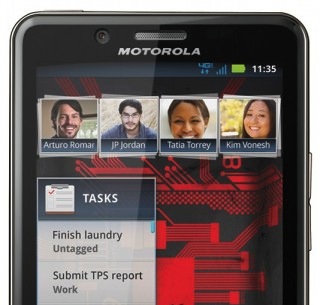Warning: Undefined array key "file" in /var/www/wp-includes/media.php on line 1763
With that, we thought it’d be fun to think about what the worst Android phones have been so far. My colleagues and I have had a fun time putting this list together and talking about what awarded each device’s spot in this list. Before we get started, there are just a couple of disclaimers to note:
- This list will look to focus on well-known phones or phones from well-known companies. It’d be far too easy to include all the terrible Chinese knock-offs we’ve had to endure over the years.
- By nature, this is a heavily subjective and opinionated topic. You will disagree with a few selections. That’s fine — we’d love to hear what you think is or isn’t one of the worst phones of all time!
So with that said, it’s time to jump into the thick of things. Get your nostalgia cap on, because this will almost certainly take us down the bumpy ol’ memory lane.
10 – HTC EVO 3D
Being someone who purchased this phone, I know first-hand just how miserable of an experience it was to own the HTC EVO 3D. It wouldn’t have been so bad if not for all the promises that were made about how this phone was going to cure cancer and change everything. I’m obviously talking about the “revolutionary” 3D camera HTC put on the back of this thing.
Believe you me — they made it sound like a huge deal, and it definitely felt like one. Upon walking out of the Sprint store the day it launched, I felt like I’d just walked out with the gods’ gift to the world. For two weeks, I’d shown my phone off to everyone — even those who didn’t care — and talked about how awesome it was.
Not one, but TWO cameras? What?! It didn’t get any better than that. I played 3D Spider-Man and watched the Green Lantern in 3D. I took video and pictures in 3D that no one could enjoy unless they had a 3D monitor or an autostereoscopic 3D device like my own. Starting to feel alone, the novelty of 3D wore off and this phone’s real worth started shining through.
Battery life was abysmal. Even with minimal screen-on time (I’m talking 30-60 minutes here) I rarely made it to 8 hours. The dual-core Snapdragon chipset in it seemed to be bogged down over time by a (then) very non-optimized version of Android and HTC Sense.
The wonderful build quality was overshadowed by the fact that the paint and metal on this thing chipped so easily that your phone was almost unidentifiable after just a few days’ use. Indeed, I’d grown to hate my HTC EVO 3D, and had no problem passing it down to my brother once the Epic 4G Touch launched just a few months later. At the end of the day, the HTC EVO 3D was one of the worst phones that ever launched, and that’s probably why we have yet to see a follow-up
9 – Samsung Continuum
I remember it like it was yesterday. Verizon sent out press invites teasing this great new phone by Samsung. The Android community quickly began trying to dissect the invite, wondering what the stock market-esque artwork meant. Could it be a new Samsung smartphone with “stock” Android?! Oh boy! The excitement was enough to tip the pot, but the day came and… the Samsung Continuum is what we got.
It’s not that the phone performed poorly, it’s just that it was pointless. And ugly. And stupid. Its claim to fame was a small “ticker” (hence the stock market stuff) on the bottom that could show key information without having to turn on the device’s decidedly small main display. From stock quotes (OK, we get it) to your latest email, and from whether updates to Twitter and Facebook updates, this little AMOLED strip was supposed to be fun. And it was supposed to help battery life, too.
The problem is that Samsung never gave a damn about it. It could have been a very exciting thing for developers to tap into, but Samsung never opened the APIs to anyone. The amount of apps you could use with the ticker display never increased.
And most of the info the display served up was so condense that you’d rather view it on the big screen anyway. Couple that with the fact that the mechanism for activating the display was so shoddy that it was useless, and you have a recipe for disaster. Needless to say, I was extremely happy to ship this phone right back to Verizon upon completing my review.
8 – Motorola DROID Bionic
What can I say about the DROID Bionic that hasn’t already been said? This phone tanked. It went through at least two or three redesigns, was delayed for months, and treated like an ugly red-headed stepchild by Verizon. And that’s just before the device launched. When the Motorola DROID Bionic finally launched, it was immediately apparent why it took Verizon and Motorola so long to get it to market — it was riddled with so many bugs that not even the most patient person in the world could deal with it.
The Bionic’s list of problems was so long that you had to wonder what, exactly, their engineers were doing in the several months that passed since its announcement. It felt like a prototype that was never quite supposed to make it out to the public, yet here it was, boxed up, on sale and advertised as one of Verizon’s biggest phones.
The problems were so numerous that I won’t even list them here — it’d probably add another 500 words to this already lengthy article. Verizon and Motorola addressed a lot in the months following its release, but all the OTA updates and tender, loving care in the world can’t wash the horrible taste it left out of our mouths. Never forget.
7 – HTC Thunderbolt
Anyone feel like we’re picking on Verizon a little bit too much here? It’s by accident, I assure you. With that, I present to you Big Red’s first ever 4G LTE smartphone — the HTC Thunderbolt. This was an exciting phone to behold when it first launched. Truth be told, the phone wasn’t super innovative or revolutionary as a whole, but the spotlight put on it for being the first phone to kick-off the 4G LTE craze certainly made it seem that way.
Verizon was bold to take the first step in changing up the high-speed data game, but it’s a shame HTC gave them a stinker of a device to do that with. The HTC Thunderbolt was a fine phone, but there was one unforgivable, undeniably damning trait that unfortunately earned the device a spot on this list — you could barely use the thing.
Battery life was so miserable that you’d be better off just grabbing a dumbphone and leaving the Thunderbolt on the charger at home. I’ve had friends who couldn’t get much more than three hours on a single charge, and that’s with moderate usage patterns. The situation was so bad that an HTC rep had to come out and apologize for it.
I have to cut HTC and Verizon some slack here — LTE was new, and it was a necessary stumble to take so that we wouldn’t have to deal with those pains today. Unfortunately, our worst phones list is unforgiving, and it won’t overlook 3 hours of battery life due to mere growing pains.
6 -Motorola CLIQ
Those without a deep knowledge of Android’s history might not have been around for the abomination that was the Motorola CLIQ. It was Motorola’s first Android phone, which is funny considering one of the best (or, perhaps, most important) phones in Android’s history — the Motorola DROID — was introduced by Motorola and Verizon just days later.
The Moto CLIQ was small, awkwardly built, and, quite frankly, ugly. And that’s just the bad news on the hardware side of things. It was our first taste of MotoBLUR, which has gained notoriety for being one of the worst custom overlays Android has ever seen. It was slow, buggy, and did nothing to properly represent the spirit of Android. My eyes and brain are bleeding out just thinking about it. Let’s be thankful Motorola came to their senses and started making phones with respectable software again.
5 – Samsung Behold II
Say what you want about TouchWiz (or Nature UX, or whatever), but it’s far from the worst user experience Samsung (or any OEM) has provided. The Behold II was the sequel to Samsung’s original line of Android smartphones (dubbed the Samsung Galaxy). Yes, it even precedes the Galaxy S line. And yes, it sucked. The button layout was laughably bad, with Samsung seemingly regurgitating a random collection of shapes onto the bottom of the display.
But that wasn’t even all that bad… it was that silly cube interface Samsung tried to market as “revolutionary” and “fun.” No. It wasn’t. It wasn’t fun at all. In fact, I loathed using this thing so much that I’d just as soon buy one of those old rotary phones and leave the Behold II in its box. Trying to launch the YouTube app or get to your messages was like trying to fit a square block into a round hole. It just wasn’t going to happen.
And even if you bypassed the cube interface, the horrid home-screen setup was just as hard to stomach as anything else. We applaud T-Mobile for being one of the first carriers to give all these bad Android phones a shot, but we won’t mince words when looking back on this abomination.
4 – Motorola Backflip (and/or Motorola Flipout)
Simply put, Motorola was out of their flippin’ minds when they thought these phones up. Motorola’s grand idea for their 2010 stretch of affordable phones was to implement these gimmicky ways to access the devices’ keyboards. For the Backflip, the keyboard actually existed on the “back” of the phone… get it? And you “flipped” it to the front so you could type. Yeah.
And the Flipout was no better. In fact, it was even worse. Here it was, a little puck whose tiny keyboard was tucked beneath a tiny screen. The only way to access that keyboard was to “flip” the phone sideways. Honestly, I probably wouldn’t have cared less if the phone accidentally “flipped” right out of my hands.
These phones were interesting — I’ll give them that much — but in the end they were cumbersome, ugly gimmicks to cover up the fact that the phones weren’t any good (with much of that having to do with MotoBLUR, which we already had the displeasure of mentioning in this article).
3 – LG DoublePlay
OK, OK. Truth be told, it does seem like I’m picking on companies for thinking outside the box. That isn’t the case at all. Think, and think some more! But think twice before turning some of these concepts into reality. I had to take a DoubleTake when LG first showed us the DoublePlay.
The idea was noble, and the second-screen experience was far more useful than that of the aforementioned Samsung Continuum’s. Still, the whole thing felt forced, and splitting the physical QWERTY keyboard into two to make room for what was little more than a glorified secondary apps tray didn’t make for the most intuitive typing experience in the world.
2 – Garmin-Asus Garminfone
As good as ASUS has been to us in the tablet side of things over the years, their track record with phones hasn’t been quite as inspiring. Their own-branded phones have been decent at best, but it’s the phones they made in conjunction with others that have us doing an about face and running the other way.
There were several elements of ASUS and Garmin’s Garminfone that earned it the number 2 spot on our list. For starters, the phone was ugly, and looked like a failed cross between a personal media player and a GPS unit. That’s the least of it. Diving deeper, ASUS and Garmin tried to create a navigation experience that the world just didn’t need.
They completely gimped Android, with no traditional home-screen to place widgets, shortcuts and folders. The OS was so heavily customized that you might not recognize it if you weren’t paying close attention. It’s not just that they customized it beyond recognition, though — we’ve seen others do this and had no qualms. Rather, we’re more upset about the fact that nothing they did made any sense or made the device useful in any way, shape or form.
Sure, you had an offline maps experience powered by the seasoned- navigational leaders at Garmin, but Google Maps was just starting to get really good at this point. Before long, this phone had become completely obsolete, and was one of several failed attempts made by Garmin and ASUS before the former thankfully decided to give it a rest. With how good Google Maps has become and with how much a standalone app can do in this day and age, let’s hope we never have to endure something like the Garminfone again.
1 – Kyocera Echo
Finally, we’ve come to the coveted (dreaded?) #1 spot. Truth be told, Kyocera has never made a really great Android phone. We’d hoped things would change when Sprint unveiled the Kyocera Echo, but that turned out to be one of the biggest faceplants we’ve ever seen in the history of smartphone announcements.
Sprint hyped the announcement of this phone up as something “magical” and “exciting,” and we all waited patiently for the event that was finally going to bring us this mystical phone. That day arrived, and suddenly Sprint’s pre-game hype made more sense. It was “magical” in the sense that someone thought this silly phone would entice someone to actually buy it. It was “exciting” to read the reactions of smartphone enthusiasts everywhere on Twitter. Not even David Blaine could get us into this phone.
This dual-screen monster was an absolute brick of a device. We’d still been searching for a phone that could provide even just a halfway-decent second-screen experience at that point, and while we commend Kyocera for giving it a try they probably would have been better off crumbling up the blueprints for this one.
For starters, the over-exaggerated bezel on this thing ruined any shot at making this device appear to have one “big” display. The idea was that the two 3.5-inch screens could be combined to form a nice, big 4.7-inch display. They called this “tablet mode,” and used the allure of being able to view photos and videos on a wider canvas to try and make sales. Needless to say, the execution of this idea was ruined by bad engineering.
Other use cases included using one display as a keyboard while viewing an app in the second display, as well as using one display to show your email inbox while using the second display to show individual emails. This was an interesting use of dual displays, but ultimately proved to be little more than a gimmicky novelty. One could also simply “close” the device and use the Echo as a single display phone, but — again — shoddy engineering meant you were holding something akin to a brick.
Buggy software, putrid battery life and uninspiring internals rounded out the list of negatives that made the Kyocera Echo the worst Android phone of all time. Think about everything you shouldn’t do when constructing a smartphone, and Kyocera did all of that in the Echo.
Runner-ups
With hundreds, and maybe even thousands of Android phones being made over the past 5 years, it was extremely hard to choose just ten devices. We felt the need to highlight a bit more, so here are some of the ones that didn’t make the cut (not in any particular order):
- LG G2x — first phone with Tegra 2, but boy was it buggy.
- HTC ChaCha, HTC Status and HTC First — we’ve all wanted a Facebook phone once. Then we grew up.


























